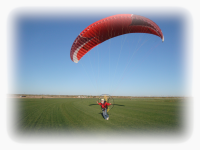What to do if there is water in the fuel
by Had Robinson
updated July 31, 2019
This spring (2019) has been one of the wettest on record for many parts of the U.S. and Europe. As a result, gasoline contaminated with water has become a common problem. Automobiles generally use ethanol blends of fuel which absorb the water (if not too much). Modern fuel injected engines do not mind the watery mix.
“Water is the single most destructive contaminant in a fuel system." Howard Chesneau Fuel Quality Services, Inc.
It is quite another matter with paramotors, especially if they use ethanol-free fuels. The water will sink to the bottom of the tank and get in the system. When this happens, the fuel pump will work intermittently, if at all, and the inlet valve filter screen will self-clog. The engine will be hard to start or suddenly quit.
If your motor is running well otherwise, suddenly quits or will not start, and the weather has been wet, take off the carburetor fuel pump cover plate and take a look. The inline fuel filter will probably have water in it, too.
Water and all types of gasoline do not mix. Pilots who must use fuel containing ethanol will have better luck because the ethanol will unlikely be 100% saturated with water which means stray water in the gasoline will be absorbed and no one will be the wiser.
Here is a photo of a Walbro WG fuel pump diaphragm covered with water. The inlet filter screen of the pump was also full of water (and ruined) and had to be replaced. This motor would neither start nor run.
The fuel system must be thoroughly purged and the carburetor examined for water. If this is not done, you will have no idea whether the carburetor is water free or not, to say nothing of the rest of the fuel system. Water and debris in the inlet valve filter screen can cause the engine to overheat when run at high loads.
The inline fuel filter should be replaced.
- Rebuild the carburetor Alternately, you might get away with just removing the pump diaphragm and letting everything dry out. Then replace the inlet filter screen with a new one (if you have an extra lying around). If not, you might be able to carefully clean it with alcohol and compressed air. It is always better to rebuild.
- Remove the tank from the frame and drain it. Handy pilots can carefully separate the good fuel and the watery gunk.
- Remove the "clunk" in the bottom of the tank and rinse in alcohol. Let it dry,
- Pour a few ounces of rubbing alcohol in the tank and shake the tank vigorously.
- Pour out the alcohol and let the tank dry out. Compressed air can help it dry quickly.
- Use compressed air to blow all lines IN THE REVERSE DIRECTION of normal fuel flow. Reinstall the "clunk" on the end of the pickup tube.
- Reassemble everything except the inline fuel filter and the line from it to the carburetor. DO NOT connect anything to the carburetor.
- Put fresh fuel in the tank and prime the fuel system with the primer tube or the squeeze bulb. Make sure fuel comes easily out of the line that connects to the inline fuel filter. Pump about a half cup (125ml) or so of fuel through the system.
- Examine the fuel that came out for the presence of debris or water. If there is anything, repeat the purge process.
- When the fuel coming out is clean, install the inline fuel filter with the line that goes to the carburetor. However, DO NOT connect the fuel line to the carburetor at this time.
- Pump a few tablespoons (50ml) of fuel through the entire system.
- NOW connect the line to the carburetor.
Following these steps will ensure there is no water anywhere in the fuel system.
Prime the system and attempt to start the engine. Things should be good to go. Remember that filters are easily clogged by water and must be replaced. The exception is the "clunk" filter.
![]()




